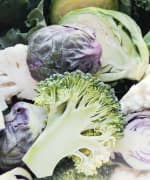Life Extension Magazine®
Caloric Restriction Protects Against Liver Disease, Animal Study Suggests
Consuming fewer calories has a protective effect against developing hepatocellular carcinoma (primary liver cancer) associated with hepatitis C virus infection, and nonalcoholic fatty liver disease, according to a rodent study published in the journal Liver Cancer.*
The study used mice with the liver cancer core gene that spontaneously develop fatty liver and tumors. For 15 months, the animals were given either a control diet that allowed them to eat as much as they liked, or a diet that contained 30% fewer calories than the control.
At the end of 15 months, animals that received calorie-restricted diets had fewer and smaller liver tumors, less liver oxidative stress, lower inflammation, downregulation of pro-cancer mediators, increased autophagy, as well as other improvements, compared to the control group.
Editor’s Note: “Recently, worldwide increases in obesity and metabolic syndrome have raised the prevalence of primary liver cancer derived from nonalcoholic fatty liver disease (NAFLD) and nonalcoholic steatohepatitis (NASH), indicating a close relationship between overnutrition and liver tumorigenesis,” the authors stated.
*Liver Cancer. 2020 Sep;9(5):529-548.
Why Does Being Overweight or Obese Increase Alzheimer’s Risk?

Numerous studies have shown that obesity increases the risk of Alzheimer’s disease, but they haven’t identified why the connection exists. A recent brain-imaging study published in the Journal of Alzheimer’s Disease has identified an underlying connection.*
Researchers analyzed over 35,000 brain scans of more than 17,000 individuals, using SPECT (single-photon emission computerized tomography). They found that people with a higher body mass index had decreased blood flow to the brain. The subjects ranged in age from 18 to 94.
Decreased brain blood flow is the number one brain-imaging predictor of Alzheimer’s disease.
As people progressed from overweight to obese to morbidly obese, reduced blood flow progressively worsened. In addition, the areas of the brain impacted by reduced blood flow were those especially vulnerable to Alzheimer’s disease.
This is one of the largest brain imaging studies, until now, tying obesity to brain dysfunction.
“This study shows that being overweight or obese seriously impacts brain activity and increases the risk for Alzheimer’s disease as well as many other psychiatric and cognitive conditions,” said Dr. Daniel G. Amen, lead author of the study, and founder of Amen Clinics.
Editor’s Note: “Overall, we have found a strong set of relationships between being overweight and obese and brain hypoperfusion across a large adult cohort spanning young adults to late life. The persistence of these abnormalities despite adjusting for demographic and psychiatric factors further highlights the need to address obesity as a target for interventions designed to improve brain function, be they AD prevention initiatives or attempts to optimize cognition in younger populations,” the authors concluded.
*J Alzheimers Dis. 2020;77(3):1331-1337.
Greater Cruciferous Vegetable Intake Associated with Less Aortic Calcification

Research findings reported in the British Journal of Nutrition reveal an association between increased intake of Brussels sprouts, broccoli, cabbage, and other cruciferous vegetables, and less extensive abdominal aortic calcification (AAC) in older women.*
Conducted by researchers from the University of Western Australia, the study included 684 women, with a mean age of 75, who had enrolled in the Calcium Intake Fracture Outcome Study in 1998. Responses to dietary questionnaires administered upon enrollment provided information about cruciferous vegetable intake. Aortic calcification was categorized as extensive or not extensive based on imaging obtained during 1998–1999.
A correlation was observed between greater cruciferous vegetable intake and a reduction in AAC. Women whose intake of the vegetables was more than 44.6 grams per day (the equivalent of ¼ cup of steamed broccoli or ½ cup of raw cabbage, for example) had a 46% lower adjusted risk of extensive AAC, compared to those whose intake was less than 15 grams daily.
Total vegetable intake, including other types of vegetables, was not related with risk.
“This study strengthens the hypothesis that higher intake of cruciferous vegetables may protect against vascular calcification,” the authors stated.
Editor’s Note: “One particular constituent found abundantly in cruciferous vegetables is vitamin K which may be involved in inhibiting the calcification process that occurs in our blood vessels,” said lead author Dr. Lauren Blekkenhorst.
*Br J Nutr. 2020 Jul 17.
Cardioprotective Benefits Found with Omega-3 Supplements

An updated meta-analysis published in Mayo Clinic Proceedings expands on an earlier one, supporting a cardioprotective role for supplementation with the omega-3 fatty acids eicosapentaenoic acid (EPA) and docosahexaenoic acid (DHA).*
This meta-analysis included 40 randomized controlled trials with a total of 135,267 participants.
Dosages of omega-3 used in the studies ranged from 400 mg to 5,500 mg per day.
Supplementation with EPA + DHA was associated with a:
- 13% lower risk of heart attack,
- 10% lower risk of coronary heart disease events,
- 35% lower risk of fatal heart attack, and
- 9% lower risk of coronary heart disease mortality.
Editor’s Note: When the impact of omega-3 dosage was examined, higher doses were more protective against the risk of cardiovascular disease events and heart attack than lower amounts.
*Mayo Clin Proc. 2020 Sep 17.

